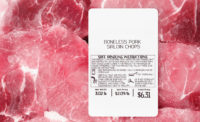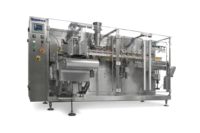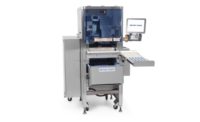Processors of meat, poultry and seafood bring a long list of required features when shopping for equipment that weighs and labels packages. Equipment must be accurate, reliable, flexible, and easy to set up, run, change over and clean with a washdown-compatible, hygienic, stainless-steel design.
In addition, whether a retail, back room or packaging line application, several questions should be answered up front:
- Does the application work best with a manual, semiautomatic or automatic system?
- What type of package is being handled? Primary? Distribution?
- What information needs to be printed? Price? Unit price? Product identification? Nutrition data or country of origin info? Safe handling instructions?
- Where will the label(s) be placed? Top? Bottom, C-style? Corner wrap? Multiple?
- What type of surface will be labeled?
- What product size(s)/weight(s) must be handled now? In the future?
- How many packs must be handled per minute now? In the near future?
- Is the system expandable?
- How will the unit integrate with existing operations?
- What built-in quality control functionality is needed?
Today’s equipment checks off every requirement on the list with precise digital weighing. Plus, there’s an ample choice of manual, semiautomatic and automatic systems; size, speed and package weight ranges; and printer and label applicator technologies. Printers rely on robust thermal, thermal-transfer or inkjet technology with print speeds that can reach 10 inches per second. Print resolution is high, typically 300 dots per inch. If high-value products are involved, it’s possible to select a printer with radio frequency identification coding capability. Large (up to 17 inches) operator interfaces with color touch screens and advanced software simplify operation and label design and printing. In many cases, software and networkability enable remote programming as well as real-time monitoring and performance reporting.
Some systems accommodate multiple labeling heads. Other available features include automatic compensation for package height variations or compatibility with package weights up to 80 kilograms. A totalizing feature can keep track of the contents of distribution packaging or pallets.
Manual systems tend to serve entry-level or retail applications but offer considerable flexibility. Some machines run in more than one mode including catchweight, fixed weight, average weight or count and may be set up to perform a dedicated function such as checkweighing, labeling or data collection. A choice of scales allows end users to match weight capacity to package size. Label print speed is fast and accuracy is high (within a few grams). Changeover time is minimized with easy access and large label rolls. Typical features include operator interfaces with large, intuitive, color touch screen displays and integrated hand-wrap stations.
Semiautomatic systems offer similar features such as the large-screen display and may include devices to expedite roll changes, the ability to print a variety of label shapes and sizes, easy label formatting and highly legible reproduction of alphanumerics, bar codes and graphics.
Automated systems are designed to handle primary packages, boxes, totes or other packaging format and typically involve one or more product handling conveyors. Label applicators precisely place labels in the desired position even on uneven surfaces with some high-speed systems capable of handling more than 100 packs per minute. To minimize changeover downtime, the most automated units eliminate most, if not all, manual adjustments. Units equipped with multiple rolls of labels address situations in which different products arrive randomly from different packaging lines. Multi-roll systems also can boost speeds up to 150 packs per minute. Automated systems offer a high level of networkability to seamlessly integrate with up- and downstream equipment such as wrappers, sorters, diverters, sleevers, metal detectors, print inspectors and/or barcode verifiers, as well as enterprise resource planning and line management systems.
Weighing/labeling systems generate benefits throughout the supply chain. Efficient weighing and labeling eliminates under- and overweight packs, minimizes giveaway and associated loss in revenue, ensures compliance with weights and measures requirements, contains costs and improves inventory control. Systems also can collect production data to enhance operational efficiency and support product traceability needs.
In addition, operations with well-chosen equipment enhance brand identity with labels that clearly communicate product information. For retailers, weighed/labeled products provide shelf-ready inventory that minimizes handling. For consumers, weigh/price labels make it easy to compare packs and purchase exactly the amount of product needed. It’s a winning technology for all stakeholders. NP







Report Abusive Comment